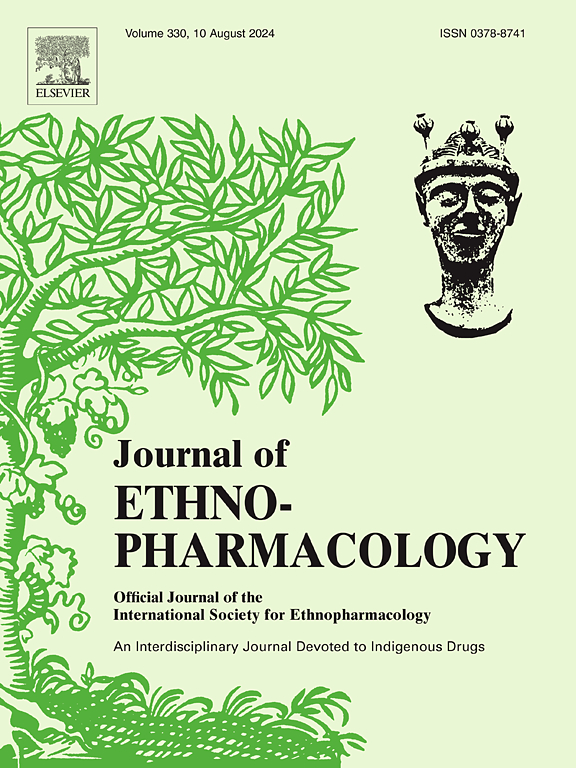Jingfang Granule promotes the tricarboxylic acid cycle to improve chronic fatigue syndrome by increasing the expression of Idh1 and Idh2
IF 5.4
2区 医学
Q1 CHEMISTRY, MEDICINAL
引用次数: 0
Abstract
Ethnopharmacological relevance
Chronic fatigue syndrome (CFS), as a complex, multisystemic, and multisystemic disorder affecting multiple organs and systems, often accompanies by symptoms such as post-exercise discomfort, sleep disorders, cognitive difficulties, and orthostatic intolerance. Jingfang Granule (JFG) is a traditional Chinese medicine that have significant protective effects on CFS, but the mechanism is still vague.
Aim of study
This study was designed to evaluate the protective mechanism of JFG on mice with CFS.
Materials and methods
The combined stimuli method was used to establish the mice CFS model, and JFG was orally administered. The body weight, exhaustion swimming training and tail suspension test were assayed every 7 days to evaluate the improvement of JFG on CFS. Lactic acid, adenosine triphosphate (ATP), malondialdehyde (MDA), superoxide dismutase (SOD), reactive oxygen species (ROS), IL-1β, TNF-α, IL-6 in serum and liver glycogen, muscle glycogen in muscle were analyzed. Transmission electron microscopy was used to detect mitochondrial morphology. The regulatory networks were investigated by proteomics and central carbon metabolomics, which were verified by Western blot.
Results
JFG reversed the loss of weight and reduce of exhaust swimming time (P < 0.05) induced by CFS in mice, and increased the tail suspension time (P < 0.05), indicating that JFG has an improving effect on CFS. Meanwhile, JFG increased the spleen index (P < 0.05), decreased the thymus index (P < 0.05) and cardiac index (P < 0.05), inhibited the secretion of Lactic acid (P < 0.05), and increased the content of liver glycogen (P < 0.05), muscle glycogen (P < 0.05), and ATP (P < 0.05), and improved mitochondrial morphology in mice with CFS. JFG also inhibited the release of TNF-α (P < 0.05), IL-1β (P < 0.05) and IL-6 (P < 0.05) in serum by inhibiting TLR4/NF-κB signaling pathway and NLRP3 inflammasome signaling pathway, and inhibited oxidative stress by activating Nrf2/HO-1/NQO1 axis. Integrated central carbon metabolomics, proteomics and Western blot showed that JFG intervened in CFS by increasing the expression of Idh1 (P < 0.05) and Idh2 (P < 0.01) to promote tricarboxylic acid (TCA) cycle.
Conclusions
This study confirmed that JFG promoted the TCA cycle by increasing the expression of Idh1 and Idh2, and then inhibited inflammation and oxidative stress to prevent CFS injury, which provided a potential drug candidate for CFS treatment.

精方颗粒通过增加Idh1和Idh2的表达,促进三羧酸循环,改善慢性疲劳综合征。
民族药理学相关性:慢性疲劳综合征(Chronic fatigue syndrome, CFS)是一种影响多器官和系统的复杂、多系统、多系统疾病,常伴有运动后不适、睡眠障碍、认知困难和站立不耐受等症状。精方颗粒是一种对慢性疲劳综合症有显著保护作用的中药,但其作用机制尚不清楚。研究目的:探讨JFG对CFS小鼠的保护作用机制。材料与方法:采用联合刺激法建立小鼠CFS模型,并口服JFG。每7 d进行体重、竭泳训练和悬尾试验,评价JFG对CFS的改善作用。分析血清乳酸、三磷酸腺苷(ATP)、丙二醛(MDA)、超氧化物歧化酶(SOD)、活性氧(ROS)、IL-1β、TNF-α、IL-6及肝糖原、肌糖原含量。透射电镜观察线粒体形态。通过蛋白质组学和中心碳代谢组学对其调控网络进行了研究,并通过western blot进行了验证。结果:JFG逆转了CFS引起的小鼠体重下降和排气游泳时间减少(P < 0.05),并增加了尾悬时间(P < 0.05),提示JFG对CFS有改善作用。同时,JFG提高了CFS小鼠的脾脏指数(P < 0.05),降低了胸腺指数(P < 0.05)和心脏指数(P < 0.05),抑制了乳酸的分泌(P < 0.05),提高了肝糖原(P < 0.05)、肌糖原(P < 0.05)和ATP的含量(P < 0.05),改善了线粒体形态。JFG还通过抑制TLR4/NF-κB信号通路和NLRP3炎性体信号通路抑制血清中TNF-α、IL-1β和IL-6的释放(P < 0.05),通过激活Nrf2/HO-1/NQO1轴抑制氧化应激(P < 0.05)。综合中心碳代谢组学、蛋白质组学和western blot结果显示,JFG通过增加Idh1 (P < 0.05)和Idh2 (P < 0.01)的表达来干预CFS,促进三羧酸(TCA)循环。结论:本研究证实JFG通过增加Idh1和Idh2的表达促进TCA循环,进而抑制炎症和氧化应激,预防CFS损伤,为CFS治疗提供了潜在的候选药物。
本文章由计算机程序翻译,如有差异,请以英文原文为准。
求助全文
约1分钟内获得全文
求助全文
来源期刊

Journal of ethnopharmacology
医学-全科医学与补充医学
CiteScore
10.30
自引率
5.60%
发文量
967
审稿时长
77 days
期刊介绍:
The Journal of Ethnopharmacology is dedicated to the exchange of information and understandings about people''s use of plants, fungi, animals, microorganisms and minerals and their biological and pharmacological effects based on the principles established through international conventions. Early people confronted with illness and disease, discovered a wealth of useful therapeutic agents in the plant and animal kingdoms. The empirical knowledge of these medicinal substances and their toxic potential was passed on by oral tradition and sometimes recorded in herbals and other texts on materia medica. Many valuable drugs of today (e.g., atropine, ephedrine, tubocurarine, digoxin, reserpine) came into use through the study of indigenous remedies. Chemists continue to use plant-derived drugs (e.g., morphine, taxol, physostigmine, quinidine, emetine) as prototypes in their attempts to develop more effective and less toxic medicinals.
 求助内容:
求助内容: 应助结果提醒方式:
应助结果提醒方式:


